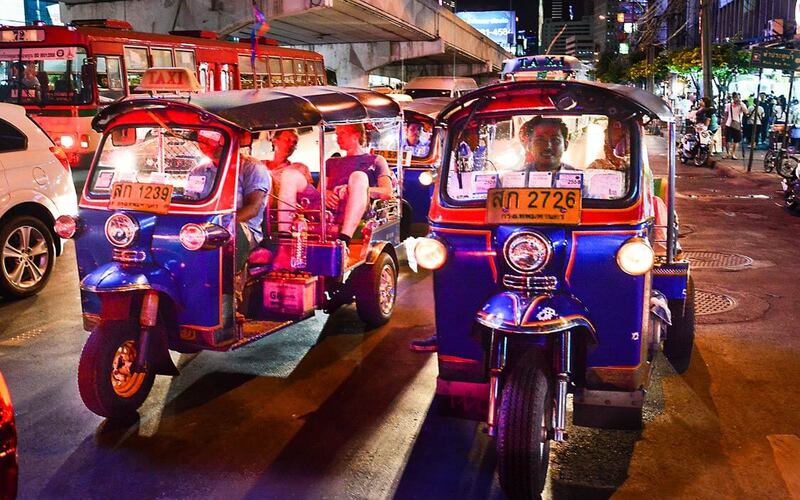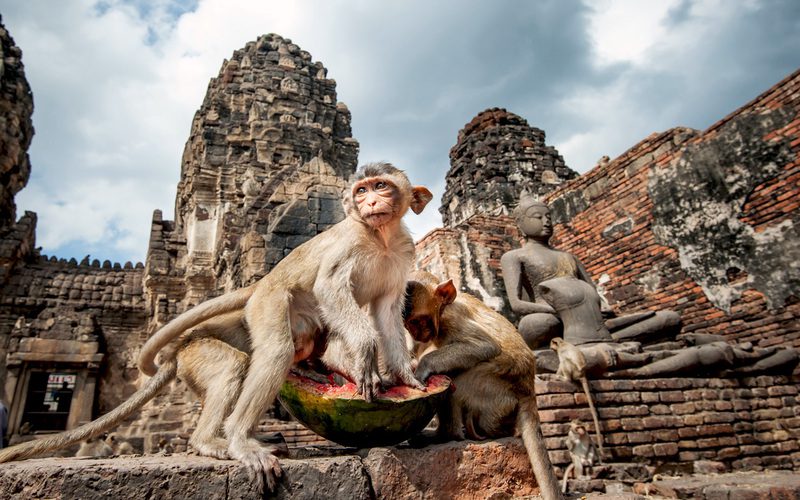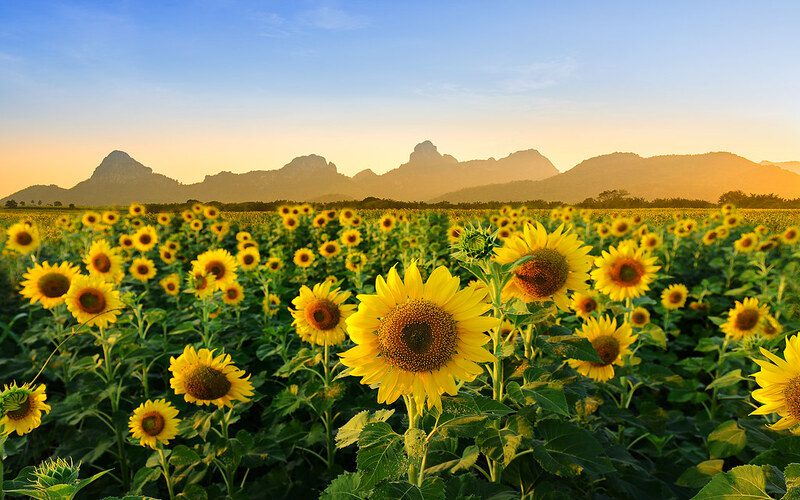Located about 150km north of Bangkok, Lopburi is an interesting destination for tourists going to Chiang Mai from the Thai capital by road or train. Besides its historical and cultural value, Lopburi is also famous for thousands of monkeys living with people throughout the city, which has become one of the special things that attract a lot of tourists here.
General Information

Lopburi – The City of Monkeys
Lopburi is a historic and vibrant city in the north of Thailand. With more than 1,000 years of history, Lopburi is one of the most attractive destinations for those who love to explore unique cultural and architectural heritage. From a distance, you can see the glittering ancient temples, the bustling night market, and the hundreds of monkeys, all of which create a multicolored picture of Thailand’s unique culture. Coming here, you can view one-of-a-kind royal and religious temples with their respective historical myths and legends, explore Buddha statues, ancient Stupa towers, and murals reflecting the reverence of Buddhism, as well as interact with the playful monkeys that have become a unique symbol of the city.
Weather in Lopburi

Lopburi climate chart
Lopburi City has a tropical monsoon climate with three main seasons: rainy season (from May to October), cold season (from November to February), and hot season (from March to April). Depending on personal preferences and preparation, you can travel to Lopburi at the following times:
Cold season (from November to February): This is the ideal tourist season in Lopburi because the weather is cool and pleasant. The temperature is slightly low, not too hot, and suitable for visiting historical sites and sightseeing.
Rainy season (May to October): The rainy season can often affect travel with frequent and heavy rain. However, the greater point is that, at this time, the landscape becomes more green and full of life, with many plants and trees growing.
Hot season (from March to April): This is the period with the highest and most humid weather in Lopburi. If you cannot stand high temperatures and harsh sunlight, you should avoid traveling during this time.
Getting to Lopburi
Plane
Lopburi City does not have its own airport, but you can get to Suvarnabhumi Airport (BKK) or Don Mueang Airport (DMK) in Bangkok, Thailand’s two largest airports. From there, you can continue by bus, car, or train to Lopburi, which is about 150-170km away.
Bus
From the Western Bus Station in Bangkok, you can catch a bus to Lopburi. There are many departures during the day, and traveling from Bangkok to Lopburi takes about 2–3 hours, depending on traffic conditions.
Car
If you want a more comfortable experience, you can rent a car from Bangkok to go to Lopburi, by booking with us in advance here. This allows you to move more comfortably according to your schedule and explore different stops along the route.
Train
From Hua Lamphong station in Bangkok, you can take the train to Lopburi at a reasonable price. There are two types of trains: fast trains (Sprinter) and slow trains (Ordinary). The Sprinter is quicker, and it takes about 1.5–2 hours to reach Lopburi.

Train to Lopburi
Getting around Lopburi
In general, moving around Lopburi is quite easy, thanks to a variety of transportation options. Here’s a quick overview of how to get around Lop Buri:
Tuk-Tuk
These three-wheeled vehicles are a common and affordable means of transportation in Lop Buri, capable of taking you to most destinations within the city.
Bicycle
Want to leisurely explore the city at your own pace? Then renting a bicycle should be a fantastic choice for you. Many rental shops around the city provide bicycles for visitors.
Motorbike
For a bit more speed and convenience, renting a motorbike is an excellent choice. But you must ensure you have a valid driver’s license and always wear a helmet for safety.
In addition to these options, you might also consider using local buses or Songthaews (shared taxis) for certain routes, especially if you prefer a more budget-friendly method of travel. Walking is also a pleasant way to experience the city’s historical sites and local culture, especially in the cooler parts of the day.

Tuk-tuk
Where to stay in Lopburi
Lopburi provides a diverse range of accommodation options to cater to every traveler’s preferences and budget. If you want to be near the city’s attractions and enjoy the nightlife, the city center is ideal, offering numerous hotels and guesthouses ranging from economical to luxurious. For a quieter environment, consider staying on the outskirts of the city, where many resorts and guesthouses also offer beautiful views and excellent facilities.
Some great options in Lopburi would be Benjatara Boutique Resort and Windsor Resort – located in peaceful areas of Lopburi, these resorts offer luxurious rooms and fantastic service, including a restaurant and a swimming pool.
For budget-conscious travelers, consider Paklop Resort which is just a short drive from Lop Buri city center – this resort provides clean and comfortable rooms for a reasonable price. Noom Guesthouse and Hop Inn Lopburi are also great choices for those wanting an affordable stay.
Best Places to Visit in Lopburi
Prang Sam Yot Temple

Exterior View of Prang Sam Yot Temple
Prang Sam Yot, which translates to “three holy prangs”, also known as The Monkey Temple, is a popular destination not to be missed on the Lopburi tourist map. The temple is more than 800 years old, considered the oldest religious architecture here, built when the city was under the control of the Khmer Empire, thus making it one of the important historical sites for portraying the influence of Khmer culture on Southeast Asia.
Phra Prang Sam Yod stands out with its unique and impressive architecture. The temple consists of three main towers, with each tower has different sizes and heights, ranging from 20 to 25 meters, creating a beautiful and unique landscape in the heart of Lopburi city.
With the divine Angkor architectural style and blending with the unique features of Thai culture, Phra Prang Sam Yod attracts the attention of tourists passionate about history and art. Exploring the temple, you will be fascinated by the refinement of the architectural details, from engraved images of gods and demons to other sophisticated sculptures.
On top of that, you certainly will be amazed by the number of monkeys here. Many tourists are fond of these little creatures, and people often feed fruits or soft drinks to the monkeys and take photos with them.

Monkey at Prang Sam Yot Temple
King Narai’s Palace
King Narai’s Palace is an important historical site in Lopburi city. Built in the 17th century during the reign of King Narai, one of the most famous and important kings of the Ayutthaya kingdom, this palace witnessed the golden days of the Ayutthaya dynasty.
King Narai’s palace has a unique blend of architectural features, combining East Asian culture and European architectural styles. This reflects the openness and integration of the Ayutthaya kingdom with European countries during that era.
The palace was built on a large area, including many buildings, walls, and lush gardens. Inside the palace, visitors can tour different rooms, halls, and large windows overlooking the surrounding area.

King Narai’s Palace
Wat Khao Wong Prachan Temple
Wat Khao Wong Prachan Temple leaves an impression on visitors with its golden Buddha statue, which is over 72m high (equivalent to a 24-floor building), located on a mountain 650m above sea level – which is also the tallest mountain in Lopburi. To get to the statue, you have to climb 3,790 steps, and from the top, you can admire the giant statue along with the panoramic view of Lopburi below.
Plenty of water is needed if you are determined to make it to the top, especially in hot weather, so many drinks are sold at rest points along the way. The climb would be a good workout experience, and you will feel worth it when finally sitting on the top of the temple, enjoying the breeze and watching swallows fly around.

Wat Khao Wong Prachan Temple
Wang Kan Lueng Waterfall
Wang Kan Lueang Waterfall is about 178km from Bangkok, a distance that takes around 3 hours to arrive. You can take a public van from Victory Monument to Tha Luang district, and from there book a rental motorbike to drive to the waterfall.
This is the waterfall famous for its fairy-like beauty, despite being a medium-sized one. The uniqueness of Wang Kan Lueng is that its stream comes from natural underground water (compared to other waterfalls where the water source comes from high mountains). The stream never dries up all year round, regardless of the rainy or dry season, making it an ideal summer destination. Coming here, visitors can enjoy the cool water while admiring the mountain and forest scenery. There are also large trees covering the surrounding area, making this place top-notch for picnics and relaxation.

Wang Kan Lueng Waterfall
Things to Do in Lopburi
King Narai’s Reign Festival
February is the peak tourist season in Lopburi – just the right time for the festival honoring King Narai (or Ramathibodi III), the 27th king of the Ayutthaya kingdom. The festival takes place about 8–10 days, depending on the year. Groups of people wearing colorful traditional costumes, riding elephants and horses, marching throughout the city, performing royal rituals and folk arts – this is a scene to be witnessed if you decide to come to Lopburi around this time.

King Narai’s Reign Festival
To pay tribute to King Narai, the festival showcases the splendor of his 17th-century reign, when Lopburi flourished as a center for art, culture, and trade. The King Narai’s Reign Festival brightens up the historical palace with colorful lights, lively music, dynamic traditional performances, and a bustling marketplace.
As night falls, the palace grounds transform into an enchanting scene illuminated by lanterns and traditional lamps. Their reflections in the palace’s ponds create a fairytale-like atmosphere. Special effects enhance the historical narrative, blending light, color, and sound to bring history to life in a captivating display.
Food enthusiasts can explore a variety of Thai delicacies at the food stalls, going through a culinary journey that captures the rich flavors of Thai culture. For those interested in hands-on activities, workshops on traditional Thai crafts are offered. Skillful artisans display the art of creating delicate silk fabrics, giving visitors the opportunity to make their own unique souvenirs.
Monkey Festival
One notable point is that every November, Lopburi has an interesting event called the “Monkey Festival”, when thousands of monkeys are revered and provided with food by local residents. If you want to experience this festival and meet adorable monkeys, this month is a great time to travel.
According to legend, King Narai really loved the monkeys and considered them his loyal soldiers. Monkeys are trusted with guarding the palace and protecting the king from enemies. To pay tribute to the monkeys for their loyalty, the king organized a whole festival dedicated to them, and this festival was held every year on the king’s birthday.

Monkey Festival
Coming to the Lopburi Monkey Festival is a great opportunity for you to learn about local culture, interact with mischievous monkeys and enjoy local cuisine. Every year, the festival invests in tons of food, mainly fruits, jellies, jams, and vegetables, with a total value of more than 10,000 USD.
On top of taking lots of photos with the monkeys, you can even watch exciting performances brought by them, such as climbing ropes, riding bicycles, and playing ball. In addition, the festival has many fun games for both children and adults, and make sure to enjoy the local cuisine to your heart’s content – the festival has many stalls selling local street food and drinks! There are also plenty of intriguing souvenirs to be bought, like monkey statues, t-shirts, and jewelry.
Visiting Pasak Jolasid Dam
A special tip for train enthusiasts is the special “Rod Fai Loi Nam” (floating train) journey from Bangkok to Pasak Joolasid Dam, Thailand’s largest earthen dam in Lop Buri province.
This route travels through several rural stations before reaching the dam. Passengers will have time to get off the train here to enjoy the impressive views and take stunning photos, before continuing with the journey to Khok Salung station, where visitors can shop for local products. You can go to the city to have fun before returning on the 3:30 pm trip, or choosing the 6:30 pm trip is also not a bad idea – just enough time to watch the sunset over the dam. The train operates from November to January and is quite popular among locals, so it’s important to remember to reserve!

Pasak Jolasid Dam
Visiting Sunflower Field
The ever-stretching sunflower field is also a tourist destination that attracts both local young people and international tourists for stunning photoshoots. It only takes about 2 hours to drive from Bangkok, so you can easily make it there in a day trip.
Among the most popular things to do in Lopburi City is to visit the nearby sunflower fields that stretch all the way to the horizon. This Instagram-worthy sunflower field is called Khao Chin Lae, located on the outskirts of Lopburi, in the Kok Toom sub-district. Sunflowers in Lopburi are grown for seeds and oil pressing, and this is also the largest flower garden in Thailand. From early November to January is the most beautiful season of Lopburi, with brilliant sunflower carpets blooming all over the hillsides, creating beautiful scenery all across Khao Chin Lae.

Sunflowers in Khao Chin Lae
Leaving the crowded city, the daily bus route gradually takes tourists into the countryside of Thailand. As soon as you see the vast, bright yellow flower fields spreading out in front of your eyes, it’s hard to resist the urge to immediately rush right into them! If you’re not in a hurry, you can also stop by a small coffee store overlooking the flower field, where you can have some breakfast, sip a cup of coffee, and warm up in the morning sun, while watching the radiant flowers with countless flocks of honey bees and colorful butterflies fluttering around.
Bottles of sunflower honey sold in the village make delicious gifts for any tourist. In addition, the village also sells dried sunflowers, sunflower seeds, and nutritious sunflower cooking oil.
What to Eat in Lopburi
Khao Pad Sapparod (Khao Pad fried rice)
What is so special about Thai Khao Pad fried rice that tourists must eat when coming to Thailand? The answer is the uniqueness of the way they enjoy this dish: Thai people still keep the familiar ingredients of fried rice, such as chicken, shrimp, crab, eggs, onions, garlic, etc. The highlight here is that their fried rice is then served in a pineapple – the fragrant, juicy part of the pineapple is taken out and mixed with rice and some roasted cashews or raisins, making the dish both beautiful and delicious. The sweet and savory taste of Khao Pad makes it a perfect dish for lunch or dinner.

Khao Pad Sapparod
Khao Kha Moo (Thai’s Braised Pork Leg)
Khao Kha Moo is a stewed pork leg dish by Thai people, often served with rice, vegetables, and boiled eggs. The special feature of this dish is that the meat is stewed until it separates from the bones, so it has an extremely rich and greasy taste. Moreover, the pork is marinated in a sweet and salty sauce before being grilled, often served with a spicy dipping sauce made from chili, garlic, fish sauce, and lime juice.

Khao Kha Moo
Tom Yum
In a hot and humid tropical climate, it’s understandable that visitors would want to find a cool and refreshing dish to savor. However, an extremely popular dish in Thailand is spicy tom yum soup, and it is often served in pots and bowls to keep the heat longer since this dish is best enjoyed while still hot.
Tom yum combines all four of the famous Thai spices – salty, sour, sweet, and spicy. A true tom yum dish must have shredded lime leaves, lime juice, fish sauce, galangal, crushed chili, and lemongrass. Spices and herbs play an important role in this soup, but the proportions vary depending on the chef. Of course, tom yum is usually very spicy, so be aware of that if you are not good with spice!

Tom Yum
Souvenirs in Lopburi
Sunflower Products
Residents of Lop Buri produce a diverse range of high-quality sunflower-based items, such as sunflower oil, honey syrup, cookies, and liquid foam baths.

Sunflower oil
Matmee Fabric
Matmee fabric, a high-quality yet affordable and easy-to-clean cloth, is commonly available in the villages of Ban Mi District. This fabric is created through a tie-dyeing process prior to weaving, producing extremely intricate designs. The technique has been practiced in Lop Buri for a long time, and Matmee weaving is a traditional craft that demands advanced skills.

Matmee fabric
Khao Phra Ngam Gems
Found in Khao Phra Ngam District, these precious stones, locally known as Hin Kiew Hanumana (Sand Stone) or Quartz, are renowed for their dazzling and glittering appearance, resembling real diamonds. The stones come in various colors, including white, pink, green, purple, and yellow. Due to their sparkling quality, these gems have recently become popular as local souvenirs.

Hin Kiew Hanumana quartz
